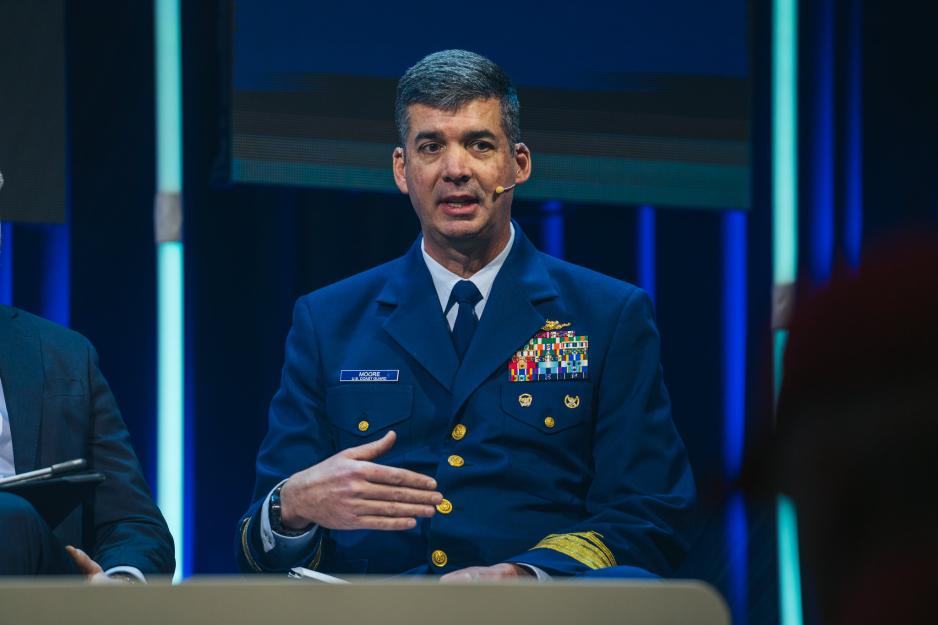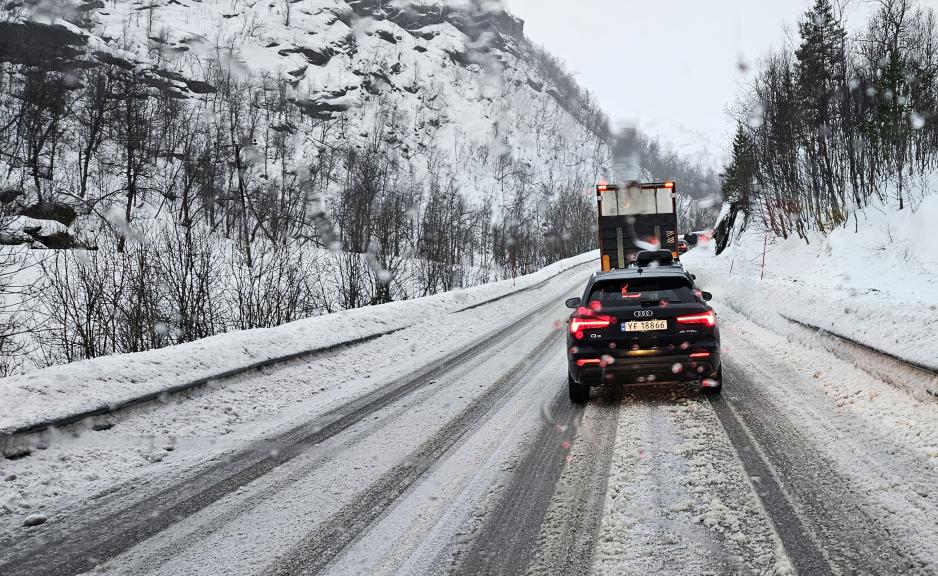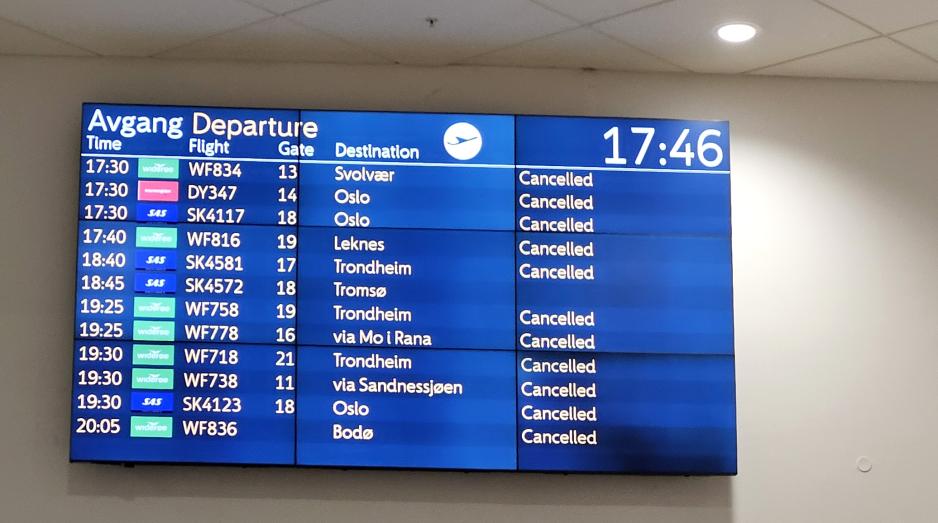Arne O. Holm says What if 20,000 Soldiers Got Stuck Behind a Trailer on the Only Road Linking North and South?

While American Adm. Nathan Moore talked about a hurricane in Alaska in September 2022, a new hurricane was raging in Northern Norway. (Photo: David Jensen)
Commentary: It was a remarkable coincidence – as if someone had written a script and later taken direction. At the same moment as a US admiral took to the stage to warn against acute crises in the Arctic, my phone made an infernal noise.
The stage belonged to the Arctic Frontiers conference in Tromsø. The admiral's name was Nathan Moore, and the distinctions on his uniform revealed that he was a Deputy Commander of the US Coastguard.
The acute crisis he spoke of was the typhoon, or hurricane as we say, which hit the western part of the US state of Alaska in September 2022. The typhoon brutally affected 35 remote and largely roadless communities in Alaska
Emergency alert on the phone
In the middle of the admiral's story-telling, in his attempt to answer questions about whether the Arctic is prepared to handle these types of emergencies, my phone awakens and provides a sort of answer.
The emergency alert, sent by the Nordland police district, is an ear-splitting alarm that reaches you even if your phone is turned off. "Acute danger," it read, from the police, followed by an order to stay indoors due to extreme weather conditions. The police had shut down the center of the city.
It was dangerous to be outside. The message was sent to about 50,000 residents and would later be sent to residents of other Northern Norwegian cities as the stormy weather moved northward.
We are militarily rearming, but what about the civil society?
One year after the typhoon hit Alaska, Public Media described what had happened in September 2022. Food storages meant to last a whole year were destroyed in a matter of hours, properties that had stood for centuries were destroyed, and vital catching equipment was annihilated.
To mention something.
I was heading to Nome
I was heading to Nome, Alaska, when the typhoon hit. The runway was damaged, and the hotels – the few that exist – were occupied by rescue crews,
At the time of writing, one and a half years later, a new hurricane rages along another Arctic coast—this time in Northern Norway. Record-breaking wind speeds are registered. Wave heights are nearing 20 meters before they crash against the shore.
Windows are ripped out of hotels and high-rise buildings before diving to the ground.
Boathouses and barns give up and break down. Roofs are torn off houses and hospitals. Logs snap like toothpicks,
And finally, a police order to stay indoors.
As usual, I participated in the Arctic Frontiers conference in Tromsø. This year's topic was "Actions & Reactions." My reaction to the warned storm was to return to Bodø a day earlier than planned.
With outside voices, the meteorologists said that all planes would likely be grounded the day after.
The Arctic is a unique area
Therefore, I followed the discussion with the admiral about "Arctic Security - Local Resilience" via a screen in Bodø while the storm raged against my windows.
"The Arctic is a unique area to operate in," said another panel discussion participant, Randy "Church" Kee from the Ted Stevens Center for Arctic Security Studies, while roof coverings were flying through the air.
"It is cold, it is dark, it is remote," he explained and added:
"We have no national security if we do not have local security."
After Russia's attack on Ukraine, war has dominated the threat assessment in the Arctic. In the North, Norway and Finland share a border with Russia. So does the US through the state of Alaska, where only the Bering Strait separates the two neighbors.
"For a long time, we have built-down preparedness. Now, we must think new about total preparedness," said State Secretary of the Norwegian MoD, Anne Marie Aanerud, who was also part of the panel.
What we have in common is the cold, the darkness, and the long distance from the power.
Military rearmament
We are well underway, the entire defense alliance NATO is well underway, with military rearmament. The exercises come close as hail in the High North. In about a month, more than 20,000 soldiers from 13 countries will practice defending what is called NATO's northern flank, or the Cap of the North, to use a more civilian term.
Swedish, Norwegian, and Finnish soldiers, supplemented by colleagues from North America and Southern Europe, will seamlessly cross national borders in the Arctic.
At sea, on land, and in the air.
They will train for a scenario in which a non-specified near-equal opponent attacks the alliance.
Perhaps we are on schedule militarily, but are we on schedule regarding civil society? This is also called total defense because civil and military are closely connected in a crisis, whether due to climate, weather, or war.
A few days ago, I drove along European Route 6 (E6), the only connection between Norway's north and south. If the road closes, there are no alternative routes. Everything stops, both military and civilian.
When the weather is so bad that the road closes, the same weather also ensures the stop of all traffic both at sea and in the air.
A single trailer
That is precisely what happened when I recently tried to move from the north to the south. A single trailer had broken down in one of more than dozens of tunnels, built in another era for another era.
Everything stopped, just like the railway plans for Northern Norway halted many years ago.
Due to the customary icy Arctic winter roads combined with pouring rain, which is becoming increasingly more typical this time of year, the rescue crew took almost 2-3 times longer than planned to reach the driver.
This stretch, a main artery in civil and military preparedness, has been in and out of the state's plans for improved logistics for decades.
"Logistics is the most important," says a panel participant in Tromsø, interrupting my train of thought. I did not catch who, but the panel was loaded with heavy civilian and military expertise.
Nonetheless, the main route, European Route 6, has spent more time outside than inside the state's financing.
Nothing has happened.

Full stop on the main road between Norway's north and south. (Photo: Arne O. Holm)
Consistent build-down
Instead, we have consistently built down preparedness while strengthening the traffic arteries in the south for those who travel to and from the capital.
This main artery in the north is so often closed that it does not go further on the news agenda than a short traffic message.
If a bus is stuck in Oslo, it reaches the top of the national news broadcasts with video and dispatched reporters. There may be reasons for that. But there is something about the proportions.
We queued for about five hours before the trailer was towed.
I could move on.
Those heading the other way, northward, were not as lucky. Trailers who had queued for hours were suddenly stuck at the first mountain pass.
And then the road was closed again.
For just under a day, the preparedness services crossed their fingers that an acute situation would not arise on the wrong side of the blocking.
Or, in more dystopian terms, that a "fictional invasion" would not become a reality, while the military forces, own or allied, would get stuck in the same queue we civilians were stranded in.
That they would not get stuck behind a trailer or, worse, an electric car that has run out of energy. Charging stations are few and far between in the Arctic if traffic stops.
Politicians, not just the wind, should take it down a notch.
Record-breaking wind
The wind speed in Alaska in 2022 was 38 meters a second. At its worst, it reached 54 meters a second in Northern Norway.
This does not mean that Northern Norway was affected more severely than Alaska. Quite the opposite. But it tells us that the Arctic consists of very different areas, both geographically and in terms of preparedness.
We have in common the cold, the darkness, and the long distance from those who make decisions.
The wind has taken it down a notch outside my window. The hurricane has become a gale. Perhaps air traffic will resume, and perhaps the final high-rise roof coverings have hit the ground. Yet, thousands are still without electricity, and airports and roads are closed.
Conference participants from all over the world are heading home from Tromsø. At the time being, those who have come furthest have only moved a few meters. They are stuck in a plane that thought it would take off over six hours ago. The airplanes cannot get in the air or back to the gate.
Those who are driving face closed mountain passes in whichever direction they go. In Harstad, the hospital is closed after the roof blew off. Cultural heritage sites and monuments that have withstood the test of time and weather are crushed to pieces.
Reports say the last conference participants will not leave Tromsø until Sunday. Four days late.

Air traffic also stopped. (Photo: Arne O. Holm)
Should take it down a notch
The wind is taking it down a notch, but so should responsible politicians be doing before they put exclamation marks after their own efforts for the Arctic civil communities.
Measures to ensure that people live in the North, the essential prerequisite for being able to defend ourselves militarily, have so far been unsuccessful in Norway and Finland.
It is impossible to make plans that prepare for any natural disaster.
However, the script must be rewritten.
And someone must take direction.




